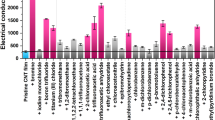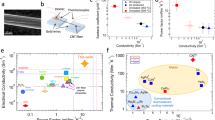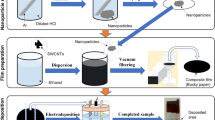Abstract
Thermoelectric power generation, allowing recovery of part of the energy wasted as heat, is emerging as an important component of renewable energy and energy efficiency portfolios. Although inorganic semiconductors have traditionally been employed in thermoelectric applications, organic semiconductors garner increasing attention as versatile thermoelectric materials. Here we present a combined theoretical and experimental study suggesting that semiconducting single-walled carbon nanotubes with carefully controlled chirality distribution and carrier density are capable of large thermoelectric power factors, higher than 340 μW m−1 K−2, comparable to the best-performing conducting polymers and larger than previously observed for carbon nanotube films. Furthermore, we demonstrate that phonons are the dominant source of thermal conductivity in the networks, and that our carrier doping process significantly reduces the thermal conductivity relative to undoped networks. These findings provide the scientific underpinning for improved functional organic thermoelectric composites with carbon nanotube inclusions.
This is a preview of subscription content, access via your institution
Access options
Subscribe to this journal
Receive 12 digital issues and online access to articles
$119.00 per year
only $9.92 per issue
Buy this article
- Purchase on Springer Link
- Instant access to full article PDF
Prices may be subject to local taxes which are calculated during checkout





Similar content being viewed by others
References
Snyder, G. J. & Toberer, E. S. Complex thermoelectric materials. Nature Mater. 7, 105–114 (2008).
Minnich, A., Dresselhaus, M. S., Ren, Z. F. & Chen, G. Bulk nanostructured thermoelectric materials: current research and future prospects. Energy Environ. Sci. 2, 466–479 (2009).
Liu, W., Yan, X., Chen, G. & Ren, Z. Recent advances in thermoelectric nanocomposites. Nano Energy 1, 42–56 (2012).
Russ, B. et al. Power factor enhancement in solution-processed organic n-type thermoelectrics through molecular design. Adv. Mater. 26, 3473–3477 (2014).
Glaudell, A. M., Cochran, J. E., Patel, S. N. & Chabinyc, M. L. Impact of the doping method on conductivity and thermopower in semiconducting polythiophenes. Adv. Energy Mater. 5, 1401072 (2015).
Kim, G.-H., Shao, L., Zhang, K. & Pipe, K. P. Engineered doping of organic semiconductors for enhanced thermoelectric efficiency. Nature Mater. 12, 719–723 (2013).
Liu, J. et al. Thermal conductivity and elastic constants of PEDOT:PSS with high electrical conductivity. Macromolecules 48, 585–591 (2015).
Weathers, A. et al. Significant electronic thermal transport in the conducting polymer poly(3,4-ethylenedioxythiophene). Adv. Mater. 27, 2101–2106 (2015).
Arnold, M. S. et al. Recent developments in the photophysics of single-walled carbon nanotubes for their use as active and passive material elements in thin film photovoltaics. Phys. Chem. Chem. Phys. 15, 14896–14918 (2013).
Habisreutinger, S. N. et al. Enhanced hole extraction in perovskite solar cells through carbon nanotubes. J. Phys. Chem. Lett. 5, 4207–4212 (2014).
Guillot, S. L. et al. Precision printing and optical modeling of ultrathin SWCNT/C60 heterojunction solar cells. Nanoscale 7, 6556–6566 (2015).
He, X. et al. Photothermoelectric p–n junction photodetector with intrinsic broadband polarimetry based on macroscopic carbon nanotube films. ACS Nano 7, 7271–7277 (2013).
Brady, G. J. et al. Polyfluorene-sorted, carbon nanotube array field-effect transistors with increased current density and high on/off ratio. ACS Nano 8, 11614–11621 (2014).
Nonoguchi, Y. et al. Systematic conversion of single walled carbon nanotubes into n-type thermoelectric materials by molecular dopants. Sci. Rep. 3, 3344 (2013).
Mai, C.-K. et al. Varying the ionic functionalities of conjugated polyelectrolytes leads to both p- and n-type carbon nanotube composites for flexible thermoelectrics. Energy Environ. Sci. 8, 2341–2346 (2015).
Tu, X., Manohar, S., Jagota, A. & Zheng, M. DNA sequence motifs for structure-specific recognition and separation of carbon nanotubes. Nature 460, 250–253 (2009).
Arnold, M. S., Green, A. A., Hulvat, J. F., Stupp, S. I. & Hersam, M. C. Sorting carbon nanotubes by electronic structure using density differentiation. Nature Nanotech. 1, 60–65 (2006).
Blackburn, J. L. et al. Transparent conductive single-walled carbon nanotube networks with precisely tunable ratios of semiconducting and metallic nanotubes. ACS Nano 2, 1266–1274 (2008).
Nish, A., Hwang, J.-Y., Doig, J. & Nicholas, R. J. Highly selective dispersion of single-walled carbon nanotubes using aromatic polymers. Nature Nanotech. 2, 640–646 (2007).
Mistry, K. S., Larsen, B. A. & Blackburn, J. L. High-yield dispersions of large-diameter semiconducting single-walled carbon nanotubes with tunable narrow chirality distributions. ACS Nano 7, 2231–2239 (2013).
Fagan, J. A. et al. Isolation of >1 nm diameter single-wall carbon nanotube species using aqueous two-phase extraction. ACS Nano 9, 5377–5390 (2015).
Yu, C., Choi, K., Yin, L. & Grunlan, J. C. Light-weight flexible carbon nanotube based organic composites with large thermoelectric power factors. ACS Nano 5, 7885–7892 (2011).
Hewitt, C. A. et al. Multilayered carbon nanotube/polymer composite based thermoelectric fabrics. Nano Lett. 12, 1307–1310 (2012).
Cho, C. et al. Completely organic multilayer thin film with thermoelectric power factor rivaling inorganic tellurides. Adv. Mater. 27, 2996–3001 (2015).
Nakai, Y. et al. Giant Seebeck coefficient in semiconducting single-wall carbon nanotube film. Appl. Phys. Express 7, 025103 (2014).
Piao, M. et al. Effect of inter-tube junctions on the thermoelectric power of mono-dispersed single walled carbon nanotube networks. J. Phys. Chem. C 118, 26454–26461 (2014).
Yu, C., Shi, L., Yao, Z., Li, D. & Majumdar, A. Thermal conductance and thermopower of an individual single-wall carbon nanotube. Nano Lett. 5, 1842–1846 (2005).
Pop, E., Mann, D., Wang, Q., Goodson, K. E. & Dai, H. J. Thermal conductance of an individual single-wall carbon nanotube above room temperature. Nano Lett. 6, 96–100 (2006).
Hone, J., Whitney, M., Piskoti, C. & Zettl, A. Thermal conductivity of single-walled carbon nanotubes. Phys. Rev. B 59, R2514–R2516 (1999).
Prasher, R. S. et al. Turning carbon nanotubes from exceptional heat conductors into insulators. Phys. Rev. Lett. 102, 105901 (2009).
Cutler, M. & Mott, N. F. Observation of Anderson localization in an electron gas. Phys. Rev. 181, 1336–1340 (1969).
Zuev, Y. M., Chang, W. & Kim, P. Thermoelectric and magnetothermoelectric transport measurements of graphene. Phys. Rev. Lett. 102, 096807 (2009).
Dowgiallo, A.-M., Mistry, K. S., Johnson, J. C. & Blackburn, J. L. Ultrafast spectroscopic signature of charge transfer between single-walled carbon nanotubes and C60 . ACS Nano 8, 8573–8581 (2014).
Chandra, B., Afzali, A., Khare, N., El-Ashry, M. M. & Tulevski, G. S. Stable charge-transfer doping of transparent single-walled carbon nanotube films. Chem. Mater. 22, 5179–5183 (2010).
Tenent, R. C. et al. Ultrasmooth, large-area, high-uniformity, conductive transparent single-walled-carbon-nanotube films for photovoltaics produced by ultrasonic spraying. Adv. Mater. 21, 3210–3216 (2009).
Mistry, K. S. et al. n-type transparent conducting films of small molecule and polymer amine doped single-walled carbon nanotubes. ACS Nano 5, 3714–3723 (2011).
Bult, J. B., Crisp, R., Perkins, C. L. & Blackburn, J. L. Role of dopants in long-range charge carrier transport for p-type and n-type graphene transparent conducting thin films. ACS Nano 7, 7251–7261 (2013).
Weisman, R. & Bachilo, S. Dependence of optical transition energies on structure for single-walled carbon nanotubes in aqueous suspension: an empirical Kataura plot. Nano Lett. 3, 1235–1238 (2003).
Capaz, R. B., Spataru, C. D., Ismail-Beigi, S. & Louie, S. G. Excitons in carbon nanotubes: diameter and chirality trends. Phys. Status Solidi b 244, 4016–4020 (2007).
Bubnova, O. et al. Optimization of the thermoelectric figure of merit in the conducting polymer poly(3,4-ethylenedioxythiophene). Nature Mater. 10, 429–433 (2011).
Bubnova, O. et al. Semi-metallic polymers. Nature Mater. 13, 190–194 (2013).
Sultan, R., Avery, A. D., Stiehl, G. & Zink, B. L. Thermal conductivity of micromachined low-stress silicon-nitride beams from 77 to 325 K. J. Appl. Phys. 105, 043501 (2009).
Avery, A. D., Mason, S. J., Bassett, D., Wesenberg, D. & Zink, B. L. Thermal and electrical conductivity of approximately 100-nm permalloy, Ni, Co, Al, and Cu films and examination of the Wiedemann–Franz Law. Phys. Rev. B 92, 214410 (2015).
Dillon, A. et al. A simple and complete purification of single-walled carbon nanotube materials. Adv. Mater. 11, 1354–1358 (1999).
Blöchl, P. E. Projector augmented-wave method. Phys. Rev. B 50, 17953–17979 (1994).
Perdew, J. P., Burke, K. & Ernzerhof, M. Generalized gradient approximation made simple. Phys. Rev. Lett. 77, 3865–3868 (1996).
Kresse, G. & Joubert, D. From ultrasoft pseudopotentials to the projector augmented-wave method. Phys. Rev. B 59, 1758–1775 (1999).
Perkins, C. L. & Hasoon, F. S. Surfactant-assisted growth of CdS thin films for photovoltaic applications. J. Vac. Sci. Technol. A 24, 497–504 (2006).
Young, D. L., Coutts, T. J. & Kaydanov, V. I. Density-of-states effective mass and scattering parameter measurements by transport phenomena in thin films. Rev. Sci. Instrum. 71, 462–466 (2000).
van Reenen, S. & Kemerink, M. Correcting for contact geometry in Seebeck coefficient measurements of thin film devices. Org. Electron. 15, 2250–2255 (2014).
Sultan, R. et al. Heat transport by long mean free path vibrations in amorphous silicon nitride near room temperature. Phys. Rev. B 87, 214305 (2013).
Acknowledgements
The investigation of the thermoelectric properties of the SWCNT networks carried out by the NREL authors was performed under a grant from the Laboratory Directed Research and Development Program at the National Renewable Energy Laboratory (NREL). The development of the s-SWCNT separations at NREL was funded by the Solar Photochemistry Program, Division of Chemical Sciences, Geosciences, and Biosciences, Office of Basic Energy Sciences, US Department of Energy (DOE). NREL is supported by the US Department of Energy under Contract No. DE-AC36-08GO28308. E.M.M. would like to thank the National Renewable Energy Laboratory Director’s Fellowship for funding. B.H.Z. and S.L.G. would like to thank the Department of Energy, Office of Science, Science Undergraduate Laboratory Internship (SULI) Program for funding. Work at KAIST was supported by the National Research Foundation of Korea (2015R1A2A2A05027766) and Global Frontier R&D (2011-0031566: Center for Multiscale Energy Systems) programmes. Work at D.U. is supported by NSF-DMR (DMR-0847796 and DMR-1410247). This work was performed, in part, at the Center for Integrated Nanotechnologies, an Office of Science User Facility operated for the US Department of Energy (DOE) Office of Science by Los Alamos National Laboratory (Contract DE-AC52-06NA25396) and Sandia National Laboratories (Contract DE-AC04-94AL85000).
Author information
Authors and Affiliations
Contributions
A.D.A., B.H.Z., R.I., K.S.M. and S.L.G. fabricated various polymer:s-SWCNT thin films. A.D.A., B.H.Z., J.L.B. and A.J.F. characterized the thermoelectric and optical properties of polymer:s-SWCNT thin films. J.L., E.-S.L. and Y.-H.K. conducted the theoretical calculations. E.M.M. conducted the photoelectron spectroscopy characterization. D.W. and B.L.Z. conducted the thermal conductivity measurements and some electrical conductivity measurements. A.D.A. and R.I. measured film thickness using atomic force microscopy. A.D.A., B.L.Z., Y.-H.K., J.L.B. and A.J.F. provided theoretical insight, data interpretation and project direction. A.D.A., J.L., E.-S.L., E.M.M., B.L.Z., Y.-H.K., J.L.B. and A.J.F. were involved in the redaction of the manuscript.
Corresponding authors
Ethics declarations
Competing interests
The authors declare no competing financial interests.
Supplementary information
Supplementary Information
Supplementary Methods, Supplementary Notes 19, Supplementary Figures 1–10, Supplementary Table 1, Supplementary References. (PDF 1171 kb)
Rights and permissions
About this article
Cite this article
Avery, A., Zhou, B., Lee, J. et al. Tailored semiconducting carbon nanotube networks with enhanced thermoelectric properties. Nat Energy 1, 16033 (2016). https://doi.org/10.1038/nenergy.2016.33
Received:
Accepted:
Published:
DOI: https://doi.org/10.1038/nenergy.2016.33
This article is cited by
-
High thermoelectric performance of flexible nanocomposite films based on Bi2Te3 nanoplates and carbon nanotubes selected using ultracentrifugation
Scientific Reports (2023)
-
Amplitude-mode spectroscopy of chemically injected and photogenerated charge carriers in semiconducting single-walled carbon nanotubes
Nano Research (2023)
-
Electrostatic charge distribution in armchair and zigzag carbon nanotubes: a numerical comparison of CNT charge models
Acta Mechanica (2023)
-
Review on Fiber-Based Thermoelectrics: Materials, Devices, and Textiles
Advanced Fiber Materials (2023)
-
Air-stable n-type transistors based on assembled aligned carbon nanotube arrays and their application in complementary metal-oxide-semiconductor electronics
Nano Research (2022)



